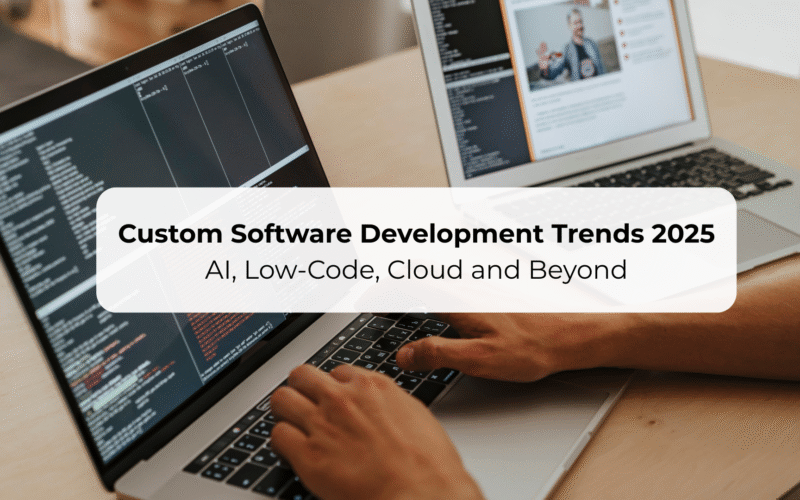Businesses across industries are increasingly turning to tailor-made software solutions to optimize processes, improve user experience, and gain a competitive edge. Custom software, built to a strictly defined set of requirements, can meet these unique needs more cost-effectively than off-the-shelf products. In today’s fast-moving tech landscape, emerging innovations like artificial intelligence, low-code platforms, cloud computing, and edge/IoT are reshaping how custom applications are conceived, built, and deployed. Companies that adopt these trends will see faster delivery, greater scalability, and new opportunities for innovation. Experienced partners like Empyreal Infotech emphasize that custom solutions are designed for specific business goals, offering benefits such as efficiency, scalability, and lower integration costs. As we approach 2025, understanding these trends is crucial for any business that wants to stay ahead.
- AI and Automation: The New Development Paradigm
Modern AI and automation tools are radically accelerating software development. Powerful coding assistants like GitHub Copilot, Amazon CodeWhisperer, and OpenAI’s ChatGPT can understand project context and auto-generate significant portions of code, documentation, and tests. Developers using AI assistance are completing tasks 30–50% faster while maintaining or even improving code quality. A recent survey reports that 63% of professional developers already use AI tools in their workflow, with another 14% planning to adopt them soon.
Generative Coding: Describe a feature in plain language and AI produces working code, interfaces, tests, and user stories.
Automated Testing & QA: AI-driven test case generation and static analysis catch bugs early in the development cycle, reducing rework. AI review tools ensure consistent coding standards and prioritize high-risk changes.
AI-Powered DevOps: Intelligent bots optimize CI/CD pipelines, auto-generate deployment scripts, and predict runtime issues. Teams using AI have fewer bugs and faster iteration, meaning deployments reach the market significantly sooner.
AI is becoming embedded throughout the development lifecycle. This new development paradigm automates routine coding tasks, letting developers focus on higher-level design and problem-solving. Leading companies are piloting autonomous code agents that can plan and execute multi-step tasks independently. At the same time, organizations must practice ethical AI and governance to ensure responsible use as AI drives custom software forward.
- Low-Code/No-Code Platforms: Democratizing Development
Low-code and no-code platforms are maturing into full-featured development environments in 2025. Instead of hand-coding every feature, businesses can use visual builders, drag-and-drop modules, and prebuilt components to create complex applications quickly. Gartner predicts that by 2025, 70% of new applications will be built on low-code or no-code platforms, up from only 25% in 2020. This massive shift is driven by demand for faster delivery and the shortage of development talent.
Rapid Prototyping and Citizen Developers: Non-technical users can assemble internal tools and workflows without writing code. This lets business units launch proofs-of-concept and automate processes in days instead of months.
Enterprise-Grade Features: Modern platforms support advanced capabilities like conditional logic, API integrations, enterprise security, and compliance. This means custom enterprise workflows can be deployed on low-code with confidence while still allowing custom code for unique requirements.
Changing Developer Roles: Rather than replacing developers, low-code shifts their focus. Developers become solution architects, integration specialists, or custom component engineers who extend platforms with reusable modules. The best practice is hybrid development: use low-code for rapid prototyping and business process automation, but rely on traditional coding for performance-critical services and complex algorithms.
Low-code platforms give businesses agility. Shorter development cycles and lower up-front costs mean faster time-to-market for new software. As Empyreal Infotech emphasizes, custom solutions today often blend low-code tools with bespoke code, delivering the perfect balance of speed and power tailored to each company’s needs.
- Cloud Computing and Cloud-Native Architecture
The cloud continues to dominate software infrastructure. Nearly 94% of large enterprises now host most of their workloads in the cloud. Small and medium businesses are following suit, with over half of SMB tech budgets projected to go to cloud services by 2025. Migrating to the cloud offers dramatic business benefits, including faster delivery and improved scalability.
Scalability and Agility: Custom cloud-based solutions can instantly scale up or down resources to match demand. Startups and growing businesses use this to spin up new services or global deployments in minutes.
Multi-Cloud and Hybrid Strategies: Organizations avoid vendor lock-in by running workloads across multiple clouds and on-premises. Most enterprises are already multi-cloud, and sovereign clouds are growing due to new regulations.
Cloud-Native Technologies: Microservices, containers, and Kubernetes are now industry standards for custom apps. Cloud-native development using serverless functions, managed databases, and API gateways makes software more resilient and easier to manage. Teams break large apps into microservices that can be updated independently. Emerging trends include service meshes and multi-cluster Kubernetes for complex distributed systems.
Built-In Security and Cost Control: Top cloud providers offer enterprise-grade security and automated compliance checks. Cloud solutions also convert CapEx to OpEx, lowering upfront costs. However, unchecked cloud spending can spiral, so DevOps teams now integrate FinOps practices to optimize costs without slowing innovation.
Overall, cloud computing enables custom software to be delivered faster and run more cost-effectively. Companies can leverage managed AI services, real-time data pipelines, and global content delivery networks as needed. Empyreal Infotech often builds cloud-based platforms so clients get the elasticity and reliability of cloud alongside modern DevOps pipelines.
Conclusion: Custom software development is rapidly evolving, driven by AI, low-code platforms, and cloud-native technologies. Businesses that embrace these trends will build scalable, efficient, and future-ready solutions in 2025 and beyond.
- Edge Computing and IoT Integration
Processing data at the network edge is a key trend, especially as Internet of Things (IoT) devices proliferate. Gartner estimates 40% of large enterprises will adopt edge computing by 2025. Similarly, IDC projects global spending on edge computing solutions at nearly $261 billion in 2025, growing to $380 billion by 2028.
Faster Response Times: With edge computing, data generated by IoT devices can be processed locally instead of traveling to a central cloud. This slashes latency and enables real-time control for safety-critical systems.
Reducing Bandwidth and Costs: Edge hubs preprocess or filter data on-site, only sending essential information to central servers. This lowers bandwidth needs and cloud costs.
IoT Device Growth: Connectivity standards like 5G and low-power networks are driving an explosion of devices. Analysts predict around 5 billion cellular-connected IoT endpoints this year.
Security and Management at the Edge: Modern custom solutions embed security features at the edge. The emerging best practice is DevSecOps, integrating automated security checks into CI/CD pipelines.
Empyreal Infotech helps clients design hybrid architectures where mission-critical functions run at the edge while aggregating results in the cloud for analytics.
- Cybersecurity and DevSecOps
Custom software is adopting a security-first mindset. Development teams are shifting security “left”, integrating it into every phase of the SDLC.
DevSecOps Adoption: Many organizations now require that DevOps pipelines include continuous security checks.
Zero Trust and Compliance: The Zero Trust model is becoming the norm. Apps often include privacy-by-design features and sector-specific compliance.
Cloud and AI for Security: Cloud-native security tools are easier to integrate than traditional systems. AI/ML is applied to threat detection and vulnerability management.
Market and Skills: The DevSecOps market is booming, projected to exceed $40 billion by 2030. Businesses are partnering with specialists like Empyreal Infotech to embed robust security into custom solutions.
- Agile Delivery, DevOps, and Continuous Innovation
DevOps and Agile remain central in 2025, with new approaches.
Platform Engineering: Organizations are building internal developer platforms to streamline workflows.
AIOps and Automation: AI optimizes monitoring, incident management, and performance.
Continuous Learning and Culture: Companies foster skills in AI collaboration, cloud-native architecture, and security best practices. Empyreal Infotech advises clients to use Agile sprints to maintain roadmaps and adopt new trends.
Conclusion: Businesses that embrace these trends will build scalable, efficient, and future-ready solutions in 2025 and beyond.
- Data-Driven Development and Analytics
Data is the new fuel for custom applications. In 2025, intelligent software not only processes transactions but continuously learns and adapts from data:
Integrated analytics: Custom software increasingly embeds real-time dashboards and AI/ML models. For example, a manufacturing app might use IoT data to predict machine failures, or a retail app might analyze customer behavior to personalize offers. These data-driven features often use cloud-based analytics services or on-device inference at the edge.
Big Data architectures: As businesses collect more data (from IoT, users, transactions), custom platforms must handle big data storage and processing. Technologies like data lakes, Kafka, and NoSQL databases are common. The trend is toward unified data architectures where all enterprise data flows into a central analytics platform for AI insights.
AI in domain apps: We’ve seen AI roles in core products: e.g. healthcare apps that interpret medical images, finance apps that detect fraud, etc. The rise of Generative AI means even content-driven apps (marketing, design, media) can auto-generate suggestions or content drafts. Businesses can leverage this by building custom solutions that weave AI models specific to their domain (sometimes in partnership with specialists).
The key impact on businesses is this: custom software is becoming a learning system. It constantly collects metrics on usage and performance, feeding improvements back into development. This data-driven feedback loop ensures that the software evolves to meet real user needs — a massive competitive advantage in 2025’s environment.
- Focus on User Experience and Cross-Platform Delivery
User expectations continue to rise. In 2025, experience design and platform versatility are top priorities in custom projects:
Progressive Web Apps (PWAs): PWAs combine web reach with native-app feel. They load instantly, work offline, and can send push notifications. By using PWAs, businesses avoid app-store delays and dramatically lower development/maintenance costs. For example, a retailer might launch a PWA storefront that performs like an app on all devices.
Cross-platform frameworks: Flutter, React Native, Xamarin, and similar tools are more mature than ever. Companies choose them to deploy to iOS, Android, and web from a single codebase, cutting time-to-market. Native development is reserved only for ultra-high-performance or hardware-specific cases.
UX and Total Experience (TX): A strong UX boosts engagement and conversions. Sunbytes notes that by 2025, “user experience is now a major focus.” Businesses are conducting extensive user research and using principles like “total experience” (integrating customer, user, and employee experiences) to guide design. The payoff is measurable: apps with intuitive interfaces see significantly higher retention and satisfaction.
Voice and AR/VR interfaces: We’re seeing more voice-activated features (AI assistants, real-time translation) and augmented reality (AR) demos, especially in retail and training. For example, a furniture company’s app may let users visualize items in their room via AR. These immersive experiences are no longer niche: improved hardware (Meta Quest 3, AR glasses) and software tools are making AR/VR integration viable for many enterprises.
In practice, this means custom software teams now include UX/UI designers, as well as front-end developers skilled in animation and interaction. The focus is on “experience over features.” Well-designed apps help businesses stand out, which in turn boosts sales and customer loyalty. EmpyrealInfotech underscores this by starting each project with UX workshops, ensuring the end product delights users while leveraging the latest interface trends.
- Other Emerging Trends: Digital Twins, Blockchain, Sustainability
Beyond the headline topics above, several specialized trends are gaining traction:
Digital Twins: Creating a virtual replica of a physical asset or system (a digital twin) has taken off. By 2025, the digital twin market is expected to hit $110 billion. Companies use digital twins to simulate and optimize operations before deploying changes. For example, a utility company might model its power grid to predict outages; a factory can test new layouts virtually. Reportedly, organizations see about 15% improvement in operational efficiency from digital twin projects. Custom software that ties IoT data, AI models, and 3D simulations together is key to enabling these gains.
Blockchain and Web3 (selective use): While blockchain hype has cooled, certain sectors still invest in it. For instance, custom supply-chain apps may use private blockchains for provenance tracking, and finance apps may integrate cryptocurrency payments or smart contracts. Industry analysts forecast the blockchain market reaching $1 trillion by the early 2030s (Sunbytes). When security and immutability are paramount, we see custom blockchain modules included. However, this tends to be on a case-by-case basis in 2025, not a default.
Sustainability and Green IT: Environmental concerns are influencing software too. Cloud providers now tout carbon-neutral regions, and custom platforms may include features to monitor energy use (e.g. data-center carbon footprint). According to Accenture, moving workloads to the cloud can cut carbon emissions by approximately 84% (CloudZero). Enterprises are even selecting development partners based on their sustainability commitments. Software projects that track ESG metrics or optimize resource usage will be increasingly valued.
Industry-Specific Clouds and Platforms: We also see the rise of “vertical clouds” – cloud services tailored to particular industries (e.g. healthcare compliance cloud, manufacturing IoT cloud). Custom developers can now build on these specialized platforms, which include prebuilt data models and compliance checks for that sector. This reduces development time for industry-specific solutions.
Each of these niche trends presents new opportunities for differentiation. The common thread is that custom software development in 2025 is not just about writing code – it’s about building intelligent, resilient, and future-ready systems that incorporate the latest technologies in service of business goals.
- How Businesses Can Leverage These Trends
To stay competitive, companies should adopt a strategic approach to custom software:
Assess business goals: Not every trend applies to every company. Firms need to choose the technologies that align with their strategy (e.g. prioritize AI and automation for a data-heavy startup, or focus on mobility and PWA for a consumer app). EmpyrealInfotech advises clients to identify the trends that map to their objectives, whether it’s scaling efficiently, enhancing customer engagement, or streamlining operations.
Invest in skills and culture: As noted, 2025’s software requires new skills – from AI prompt engineering and cloud architecture to cybersecurity and UX design (Graphite). Businesses should train or hire accordingly. Creating cross-functional teams (developers, data scientists, DevOps, designers) and a culture of continuous learning ensures these innovations are harnessed properly.
Partner with experts: Given the complexity of these trends, many organizations work with experienced development partners. A firm like EmpyrealInfotech brings deep expertise in custom solutions, combining the latest AI, cloud, and security practices into one package. They can help translate business needs into scalable software architecture, and keep the codebase modern as technology evolves.
Focus on agility: Implementing these trends is an ongoing process. Adopting DevOps and Agile methodologies ensures that even after launch, software can quickly integrate new features (e.g. a new AI model or a microservice). Regularly updating and iterating on the product is key.
Measure impact: Finally, leverage analytics. Track KPIs like time-to-market, user adoption, and ROI. This helps justify the investment in advanced tech and guides future decisions (e.g. which AI feature generated the most value).
In summary, staying ahead in 2025 means combining a clear strategy with cutting-edge technology and strong execution. Companies that align their software roadmap with these emerging trends – ideally with a trusted partner – will be poised to outpace the competition.
Conclusion and Next Steps
Custom software development in 2025 is defined by intelligence, agility, and security. From AI-driven development tools to scalable cloud/edge platforms, these technologies are transforming what software can do for business. By embracing trends like low-code automation, cloud-native architectures, and data-driven features, companies can dramatically accelerate innovation and create software that grows with them. A focus on user experience and security ensures that these solutions are not only powerful but also trusted by customers and stakeholders. The takeaway for any business is clear: invest in these trends now, or risk falling behind. Partnering with a specialized development team makes this easy. EmpyrealInfotech, for example, has deep experience in building innovative custom software solutions that leverage AI, cloud, and emerging technologies. They can help cut through the hype and implement the trends that make sense for your business, ensuring your software is secure, scalable, and future-ready. Discover how EmpyrealInfotech can help your business stay ahead with innovative custom software solutions tailored to the latest trends.







